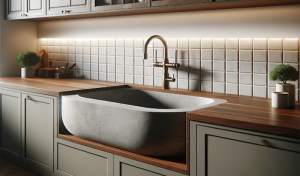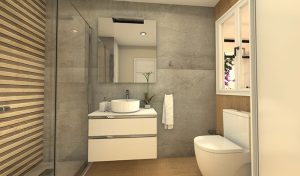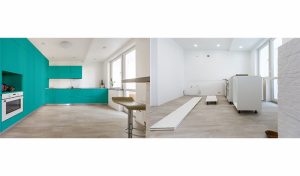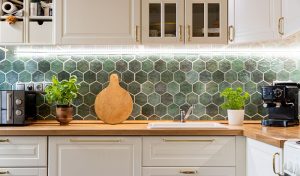Laminate flooring is a viable flooring choice if you love the look, grain, and color of hardwood floors without the cost or maintenance involved. Modern laminate products are a budget friendly alternative, yet find their way into high-end homes.
What Is Laminate Flooring?
Invented in Sweden in 1977, the product came to the U.S. in 1994. Laminate closely resembles wood in the pattern and color because a photographic process captures the appearance of hardwood. Beneath the surface, laminate is fiberboard pressed between two layers of melamine, while some products offer real wood veneers. Direct Pressure Laminate (DPL) has four layers to make it long-lasting:
- Wear layer – the top layer which protects the floor from fading, stains, scuffs and scratches.
- Design Layer – the photographic image of wood, stone, or other visual glued to the inner core.
- Inner Core –a plastic resin for structural strength that keeps the laminate stable and flat.
- Backing – the bottom layer creates a moisture barrier that protects the floor from warping.
Newer products, called High Pressure Laminate (HPL), have a fifth layer of special high-strength paper that makes it extra durable in high traffic areas. The backing and top wear layers are treated separately and then fused directly onto the core to create an extra strong floor suitable for very heavy traffic.
The product is often sold in multiple grades.
- AC1 – Moderate Residential for very light traffic and bedrooms
- AC2 – General Residential for moderate traffic
- AC3 – Heavy duty residential/moderate commercial for all residential use and light commercial traffic
- AC4 – General commercial for all residential and commercial spaces with heavy traffic
After picking a pattern you like, you should choose the highest grade you can afford for best results in heavy traffic. At a big box store, AC4 costs two or three times as much as AC1, but you are talking about a difference of $1 per square foot vs. about $2.50 for a top rated product. In comparison, hardwood might cost $8 to $14 per square foot.
What to Know About Laminate
The product can be laid over any flat surface and is either glued in place or locked in place with a tongue and groove styling and “floated” over an underlayment of film that reduces sound and moisture. Since laminate is thin, it does not vary the height of the floor from room to room, which is ideal for remodels. Installing laminate flooring is less labor-intensive than hardwood and can be a DIY project for some savvy homeowners.
Unlike hardwood, which can be sanded and re-stained dozens of times in its life time, laminate cannot be refinished, as the grain and color go no further than the surface. However, you can restore chips and make scratches virtually invisible. Some laminate is cheap and looks it, but good quality laminate can last for more than 20 years.
While it can withstand surface water, continuous moisture can impact the core and affect performance. If water sits on it too long, however, you can easily replace a bad section if you have a locking type of flooring. The sensitivity of laminate to water makes it a poor choice for bathrooms and will only work in kitchens if you are diligent about wiping up spills. However, it works well for virtually any other room in the house.
Installing Laminate Floors
If you decide to install laminate floors in your home, work with Mountain States Kitchen and Bath, an experienced contractor who will help you pick the best quality, certified flooring product.








